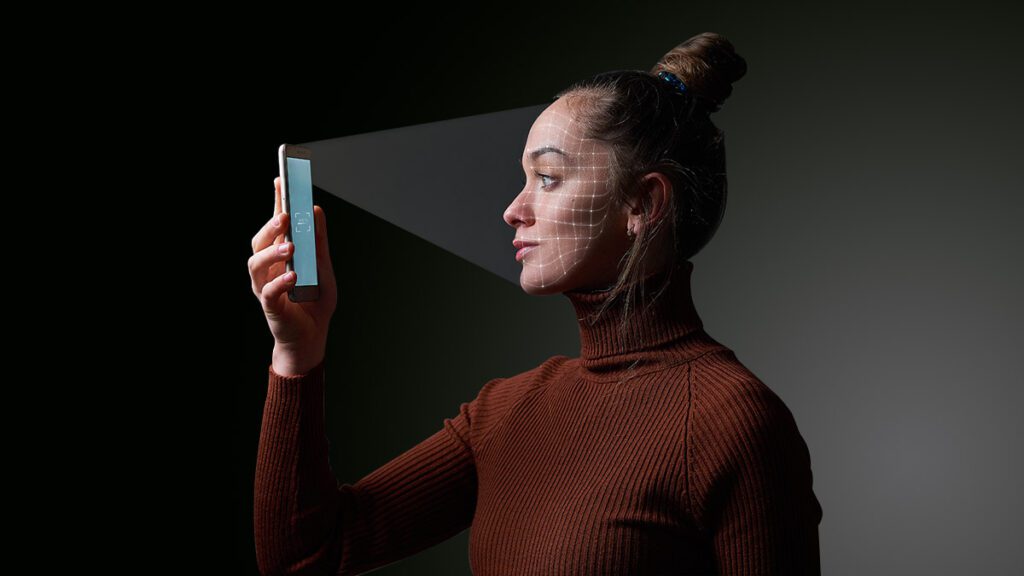 Woman scans face using facial recognition system on mobile phone for biometric identification. Future high tech technology and face id
Woman scans face using facial recognition system on mobile phone for biometric identification. Future high tech technology and face id The world of artificial intelligence (AI) hasn’t stopped surprising us. As AI algorithms are evolving towards the ultimate target of mimicking the learning process in the human brain, increasingly sophisticated applications are emerging. Lengthy procedures, complex operations, and data-intensive decision-making problems are gradually being replaced by AI-based automated paradigms that try to learn from the collected data they are presented with to ultimately produce outputs which match or complement what the decision makers are trying to achieve. Trying to verify an individual’s age without referring to an official document is crucial especially in a digital world where tools can be used to forge several personal traits enabling illegal access to age-restricted products, websites, services, etc. To this end, the use of AI as a biometric verification tool is crucial in allowing online scrutineering akin to traditional document checking.
What is Biometric Age Verification?
Digital onboarding is the common term use to denote the process of bringing in new customers to able to use the services on an institution or a business. These include services provided by governments, banks and financial institutions, healthcare providers, commercial and content distribution websites, among others. In a nutshell, digital onboarding replaces the physical process of presenting documents in person to get access credentials. With the presence of the dark web, the process becomes more important as access to weapons and other illegal and harmful tools is widely available to anyone.
Biometric age verification is an addition to the pool of techniques that use unique human characteristics to authenticate a person. Fingerprints, facial features are the common traits currently used to properly verify the identity of an individual. The popular use of facial features is currently to unlock a smart device or even get access to a personal account without going through password verification. The same or a different set of facial features can similarly be used for age verification.
AI Age Estimators
Age estimation using artificial intelligence relies on deep neural networks. In the neural network jargon, the presence of many layers is important to extract and relate all the information from the facial features to make the appropriate decisions.
AI age estimators use a two-step approach that involves facial recognition and document verification. The facial recognition system first detects liveliness to ensure no image or recorded video is used to spoof the system. The AI algorithm would output a certain age range for the user. Age estimation is sometimes backed with a digital document verification, as another layer of security. The second step is necessary when the AI age estimator provides a broad output age range.
How Accurate is Aging AI?
The accuracy of Aging AI is inherent to the properties of the algorithms used. In general, artificial intelligence algorithms suffer from many potential problems related to how they fit to the training data they are provided with. Overfitting, underfitting and bias are common problems in AI circles. Capturing the correct number of features is very important in producing a good age estimate.
The aging process is also different for human beings. While some develop aging marks at early years, other age much slowly. This is quite problematic if the AI algorithm is the only reference to estimate the age of the user. Also, similarly to face verification security mechanisms, 3D models can be developed to fool the AI algorithm.
In short, the accuracy of aging algorithms depends on a large number of factors. The algorithm parameters and hyperparameters can certainly be tuned to reduce the errors in age estimation, however some factors are beyond the algorithm itself. The official documents are a necessity as a second step to complement the outcome of the AI algorithm.
Commercial AI-based Biometric Age Verification Tools
There are a lot of commercially available tools that are widely used for age verification purposes.
Yoti Age Verification
Yoti has developed a suite of age verification services which are available for personal use through a developed app and other services dedicated to businesses and industries. In addition to AI-based age verification and the Yoti app, the company provides other verification techniques that rely on ID documents, credit card information, mobile provider details, and database personal information. That is, Yoti uses all available data and their customized AI algorithm to provide the best verification outcome. Although Yoti claims no data is shared to protect the user’s and their customers’ brand, one should always know the basics on how to protect personal data.
iProoV
iProoV is another platform that is used for onboarding and authentication. iProoV has an extended list of partners in Europe and abroad, in different industries. iProoV emphasizes the use of advances in AI, behavioral science, optics, computer vision and cryptography in the development of their solution. On the surface however, both Yoti and iProoV have a lot in common in terms of the offered functionalities.
Other online platforms such as Verifai and ICU intelligent identification provide a similar verification approach that include anti-spoofing and liveliness checks.
Summary
Using AI as a biometric age verification tool is promising in enabling digital solutions. The authentication and age verification are essential to ensure that the services are delivered to the intended group of customers. As with any AI algorithm, achieving very high accuracy levels depends on the how the algorithm is tuned and how it deals with the training data it is provided with. This said, official ID documents are essential to cover any bias or error from the AI-based solution.
“Inside Telecom provides you with an extensive list of content covering all aspects of the tech industry. Keep an eye on our Artificial Intelligence space to stay informed and up-to-date with our daily articles.”